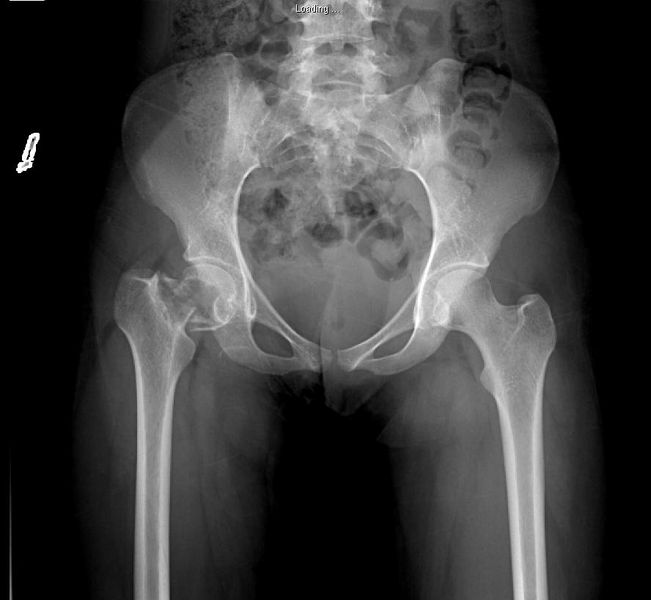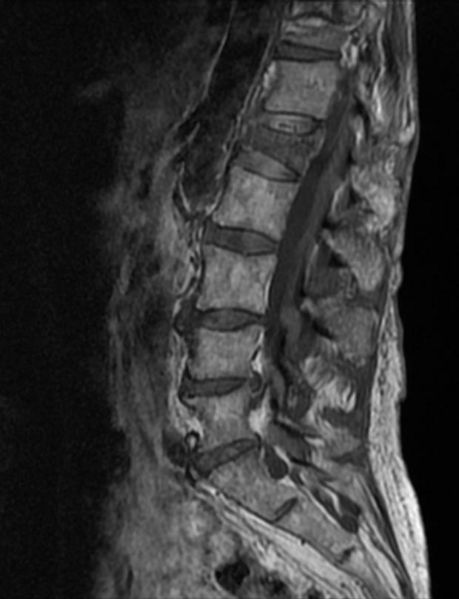Osteoporosis natural history, complications and prognosis: Difference between revisions
No edit summary |
No edit summary |
||
| Line 31: | Line 31: | ||
==Prognosis== | ==Prognosis== | ||
* | * If the bone mass density loss is identified early and the appropriate medicine begin as soon as possible, the prognosis of osteoporosis would be good. | ||
* [[DVT]] caused by prolonged immobility | * [[DVT]] caused by prolonged immobility caused by hip fractures, is associated with a poorer prognosis among patients with osteoporosis. | ||
{| class="wikitable" align="right" | {| class="wikitable" align="right" | ||
|+ Hip fractures per 1000 patient-years<ref name="pmid17846439">{{cite journal |author=Cranney A, Jamal SA, Tsang JF, Josse RG, Leslie WD|title=Low bone mineral density and fracture burden in postmenopausal women |journal=CMAJ |volume=177 |issue=6 |pages=575–80 |year=2007|pmid=17846439 |doi=10.1503/cmaj.070234}}</ref> | |+ Hip fractures per 1000 patient-years<ref name="pmid17846439">{{cite journal |author=Cranney A, Jamal SA, Tsang JF, Josse RG, Leslie WD|title=Low bone mineral density and fracture burden in postmenopausal women |journal=CMAJ |volume=177 |issue=6 |pages=575–80 |year=2007|pmid=17846439 |doi=10.1503/cmaj.070234}}</ref> | ||
| Line 43: | Line 43: | ||
| Osteoporosis || 22.4 || 46.6 || 40.6 | | Osteoporosis || 22.4 || 46.6 || 40.6 | ||
|} | |} | ||
* The lifetime fracture risk in | * The lifetime fracture risk in Caucasian women is 18% for hip fractures, 16% for spine fractures, and 16% for wrist fractures. In men the same fractures account for 6%, 5%, and 3% respectively. | ||
* More than half of all women, and one third of all men, have osteoporotic fractures in their lifetime. | * More than half of all women, and one third of all men, have osteoporotic fractures in their lifetime. | ||
* Men have a higher mortality from fractures when compared to women. | * Men have a higher mortality from fractures when compared to women. | ||
Revision as of 20:05, 3 August 2017
|
Osteoporosis Microchapters |
|
Diagnosis |
|---|
|
Treatment |
|
Medical Therapy |
|
Case Studies |
|
Osteoporosis natural history, complications and prognosis On the Web |
|
American Roentgen Ray Society Images of Osteoporosis natural history, complications and prognosis |
|
FDA on Osteoporosis natural history, complications and prognosis |
|
CDC on Osteoporosis natural history, complications and prognosis |
|
Osteoporosis natural history, complications and prognosis in the news |
|
Blogs on Osteoporosis natural history, complications and prognosis |
|
Risk calculators and risk factors for Osteoporosis natural history, complications and prognosis |
Editor-In-Chief: C. Michael Gibson, M.S., M.D. [1] Associate Editor(s)-in-Chief: Raviteja Guddeti, M.B.B.S. [2]
Overview
Osteoporosis can be complicated by the development of fractures. The prognosis is generally good and mortality from the disease will depend on the the type of fracture. The major type of fractures contributing to mortality in these patients are vertebral fractures and hip fractures.
Natural history
- Typically, symptoms of osteoporosis are developed in the sixth decade of life. The risk of getting osteoporosis is increased proportionately with age.
- Researchers have shown that relationship between lowering bone density of spine and age is not linear, but quadratic; in which bone loss tailing off when age raised. During the first years of post-menopausal period, women would have a fast decrease in bone density of spine by rate of 3.12% annually; then the rate slowed down to 0.02% per square age increased.[1]
- However, Guthrie also mentioned that in first 3 years after menopause, the rate of decreasing bone density increased annually; then with years past from menopause, the rate of bone loss will slow down.[2]
- One another major factor that directly impact on changing BMD is body weight; women with heavier weight and also higher body mass index (BMI) may have more change in their BMD in both hip and lumbar spine, during the time.
- Surprisingly, the bone site is an important factor to determine the measure of bone loss. The studies have found that magnitude of bone density loss is higher at spine (-3.12% annually) compared to femoral neck (1.67% annually). The main proposed theory for the phenomenon is "different effect of estrogen deficiency on different bone sites". On the other hand it may show the preventive effect of weight bearing on hip osteoporosis.[1]
- With appropriate and timely usage of medications along with calcium and/or vitamin D supplementation, the outcome of osteoporosis is usually good. But if the disease left untreated, or not favorably treated, the clinical consequence would be fracture and the morbidity that happen thereafter. The main type of fracture that influence the quality of life more and happened earlier, is vertebral fracture.[3]
Complications
- The major probable complications of osteoporosis include:
- Fractures: hip and lumbar spine are among the most frequent sites of fracture.

|

|
- Deep venous thrombosis (DVT): it can be caused by prolonged immobility.
- Kyphosis (Dowager's hump): the main reason could be decreasing the height of anterior aspect of cervical vertebrae body (wedge shape).
- Restrictive lung disease: because of decreasing thoracic space, due to vertebrae body compression.
- Apart from risk of death and other complications, osteoporotic fractures are associated with a reduced quality of life due to immobility; emotional problems may also arise as a consequence.[4]
Prognosis
- If the bone mass density loss is identified early and the appropriate medicine begin as soon as possible, the prognosis of osteoporosis would be good.
- DVT caused by prolonged immobility caused by hip fractures, is associated with a poorer prognosis among patients with osteoporosis.
| WHO category | Age 50-64 | Age > 64 | Overall |
|---|---|---|---|
| Normal | 5.3 | 9.4 | 6.6 |
| Osteopenia | 11.4 | 19.6 | 15.7 |
| Osteoporosis | 22.4 | 46.6 | 40.6 |
- The lifetime fracture risk in Caucasian women is 18% for hip fractures, 16% for spine fractures, and 16% for wrist fractures. In men the same fractures account for 6%, 5%, and 3% respectively.
- More than half of all women, and one third of all men, have osteoporotic fractures in their lifetime.
- Men have a higher mortality from fractures when compared to women.
- The 6-month mortality rate following hip fracture is approximately 13.5%.
- Vertebral fractures, while having a smaller impact on mortality than hip fractures, can lead to severe chronic pain of neurogenic origin which is difficult to treat, as well as postural deformity.
References
- ↑ 1.0 1.1 Zhai G, Hart DJ, Valdes AM, Kato BS, Richards JB, Hakim A; et al. (2008). "Natural history and risk factors for bone loss in postmenopausal Caucasian women: a 15-year follow-up population-based study". Osteoporos Int. 19 (8): 1211–7. doi:10.1007/s00198-008-0562-x. PMID 18305885.
- ↑ Guthrie JR, Ebeling PR, Hopper JL, Barrett-Connor E, Dennerstein L, Dudley EC, Burger HG, Wark JD (1998). "A prospective study of bone loss in menopausal Australian-born women". Osteoporos Int. 8 (3): 282–90. doi:10.1007/s001980050066. PMID 9797914.
- ↑ Lips P, Cooper C, Agnusdei D, Caulin F, Egger P, Johnell O, Kanis JA, Liberman U, Minne H, Reeve J, Reginster JY, de Vernejoul MC, Wiklund I (1997). "Quality of life as outcome in the treatment of osteoporosis: the development of a questionnaire for quality of life by the European Foundation for Osteoporosis". Osteoporos Int. 7 (1): 36–8. PMID 9102060.
- ↑ Brenneman SK, Barrett-Connor E, Sajjan S, Markson LE, Siris ES (2006). "Impact of recent fracture on health-related quality of life in postmenopausal women". J. Bone Miner. Res. 21 (6): 809–16. doi:10.1359/jbmr.060301. PMID 16753011.
- ↑ Cranney A, Jamal SA, Tsang JF, Josse RG, Leslie WD (2007). "Low bone mineral density and fracture burden in postmenopausal women". CMAJ. 177 (6): 575–80. doi:10.1503/cmaj.070234. PMID 17846439.